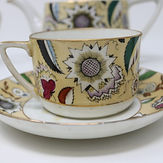Philadelphia Commercial Museum Collection
COLLECTION DESCRIPTION
The Philadelphia Commercial Museum was founded in 1897 by Dr. William P. Wilson and was initially intended to be a permanent World’s Fair exhibition located in Philadelphia (Conn 1998:532). Its exhibits depicted global commerce and sought to entice trade between the US and other countries around the world. More importantly, the purpose of the Commercial Museum’s collections was to reassure American investors and businessmen that commercial expansionism could bring all of the benefits of imperialism, without any of the negatives (Conn 1998:534).
In the context of museum studies, the Commercial Museum presents a unique perspective because its approach was so heavily entrenched in the idea of commercial expansionism and imperialism. Objects selected to be included in the museum’s collections and put on display were deemed important not because they were attempting to relay a truthful ethnographic approach to these cultures. Rather, objects were chosen based on their ability to reveal “commercial possibilities” in the targeted countries and areas of the world (Conn 1998:543).
This collection includes pieces from the 1894 Chicago World's Fair as well as pieces collected throughout the museum's history. The museum closed in 1994 and the Temple Anthropology Museum acquired the collection in the following years.
FEATURED EXHIBITS
To learn more, explore our exhibits featuring the Commercial Museum Collection





